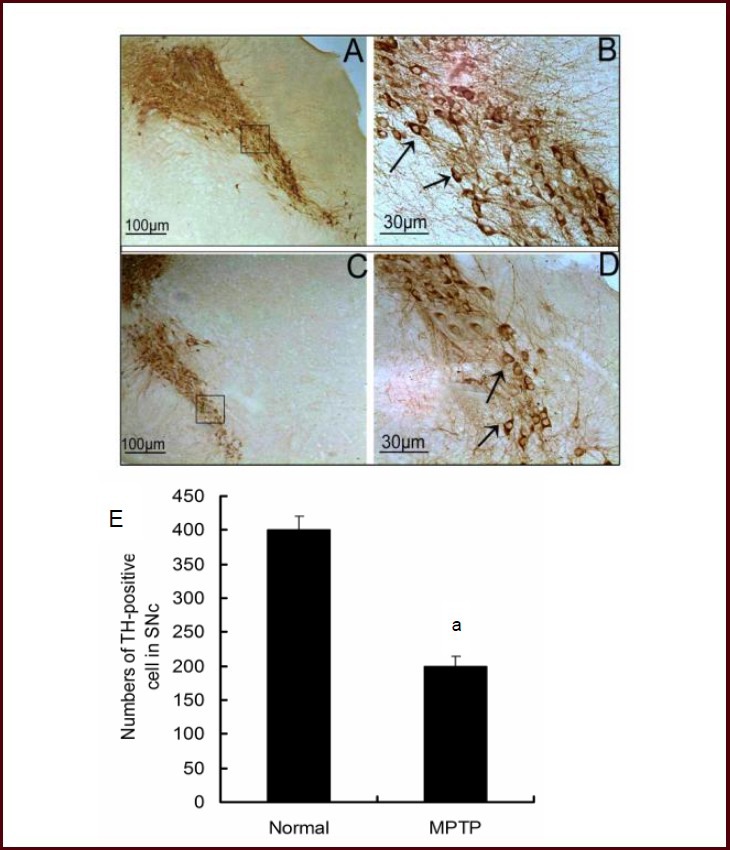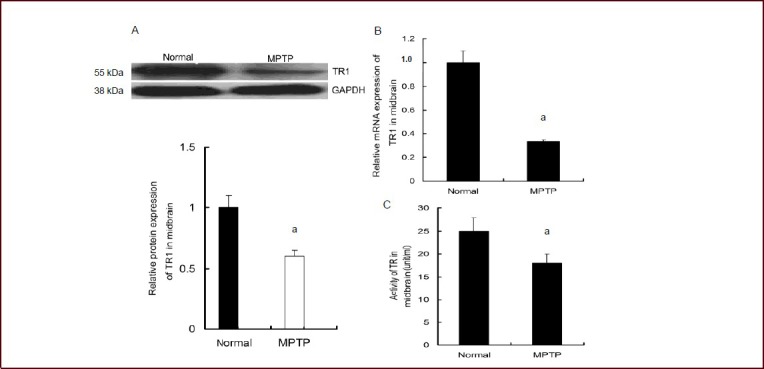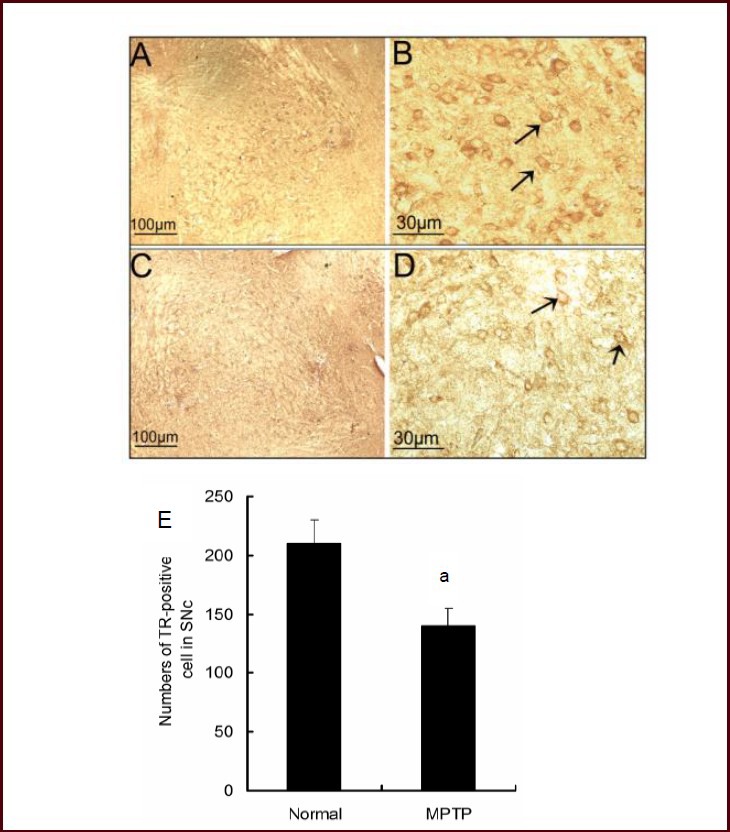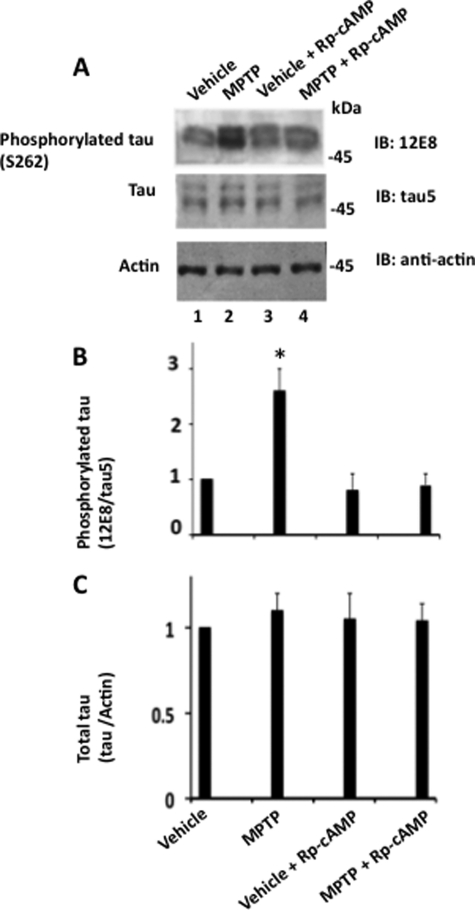
| Size | Price | Stock | Qty |
|---|---|---|---|
| 10mg |
|
||
| 25mg |
|
||
| 50mg |
|
||
| 100mg |
|
||
| 250mg |
|
||
| 500mg |
|
||
| Other Sizes |
|
Purity: ≥98%
MPTP hydrochloride is a dopaminergic neurotoxin and cause selective destruction of dopaminergic neurons in animal models of parkinsonism. MPTP prevented ICR mice's (20–30 g) phrenic nerve–hemidiaphragm preparations from exhibiting nerve-evoked twitches. MPTP, TC, and PP all had twitch inhibition IC50 values of 53, 0.7, and 123 uM, respectively.
| Targets |
Dopamine neurotoxin
|
|
|---|---|---|
| ln Vitro |
|
|
| ln Vivo |
|
|
| Enzyme Assay |
MPTP prevented phrenic nerve-hemidiaphragm preparations from ICR mice (20–30 g) from experiencing nerve-evoked twitches. The MPTP's inhibitory effect was amplified by PP 50 uM but not by PA 50 uM or TP 50 uM. The amplitude of twitch was inhibited by PP 100 uM alone. The MPTP, TC, and PP twitch inhibition IC50 values were 53, 0.7, and 123 uM, in that order. MPTP and TC had IC50 values of 18 and 0.3 uM, respectively, after pretreatment with PP 50 uM.
|
|
| Cell Assay |
N2AB-1 and C6 glioma cells were plated using the culture medium previously mentioned in 24-well costar dishes (16 mm diameter), with 50,000 cells per well. Following a 24-hour period, duplicate medium containing different MPTP or MPP+ concentrations was added. After three days of treatment, both control and treated cells were trypsinized and their counts were measured using a hemocytometer each day.
|
|
| Animal Protocol |
|
|
| ADME/Pharmacokinetics |
MPTP metabolism[4]
The metabolism of MPTP is a complex, multistep process2. After its systemic administration, MPTP, which is highly lipophilic, rapidly crosses the blood–brain barrier. Once in the brain, the protoxin MPTP is metabolized to 1-methyl-4-phenyl-2,3-dihydropyridinium by the enzyme monoamine oxidase B (MAO-B) within non-dopaminergic cells, and then (probably by spontaneous oxidation) to 1-methyl-4-phenylpyridinium (MPP+), which is the active toxic compound. Thereafter, MPP+ is released into the extracellular space. Since MPP+ is a polar molecule, unlike its precursor MPTP, it cannot freely enter cells, but depends on the plasma membrane carriers to gain access to neurons such as dopaminergic neurons. MPP+ has a high affinity for the plasma membrane dopamine transporter18, as well as for norepinephrine and serotonin transporters. Once inside dopaminergic neurons, MPP+ can be sequestrated into synaptosomal vesicles19 or be concentrated within the mitochondria20. This complex toxicokinetics implies that a proper interpretation of results from an MPTP study will require assessment of key aspects of MPTP metabolism to ensure that the observed effects are related to a true and meaningful molecular event and not to interference with the pharmacology of the toxin. The assessment may involve, but should not be limited to, assessing striatal MPP+ levels (discussed below) as well as MAO-B activity, lactate levels and [3H]dopamine and [3H]MPP+ uptake. Protocols for these analyses can be found in references cited below. |
|
| References | ||
| Additional Infomation |
In this study, researchers report the development of two animal models in amphibians (frogs and salamanders) in whom 1-methyl-4-phenyl-1,2,3,6-tetrahydropyridine (MPTP) produces the behavioral (neurological) and biochemical equivalents of the human disease and, in addition, a measurable modification in at least one form of pigment-bearing cell from the neural crest, the skin melanocyte. We propose that this new approach can become an inexpensive, easily quantifiable model for the study of the effect of MPTP on the central and peripheral nervous systems. We also demonstrate that the toxic effect of MPTP can be completely abolished in vivo by treatment with a monoamine oxidase inhibitor and potentiated by an inhibitor of catechol-O-methyltransferase. MPTP is catabolised by oxidation into toxic metabolites, but 1-methyl-4-phenylpyridinium ion (MPP+), the proposed end-metabolite, is even more toxic than MPTP in this model, possibly through a different mechanism.[1]
Potentiation by 4-phenylpyridine (a MAO-B inhibitor) on the neuromuscular blocking action of 1-methyl-4-phenyl-1,2,3,6-tetrahydropyridine (MPTP) was studied in mouse phrenic nerve-diaphragm. MPTP blocked nerve-evoked twitches in a concentration (1-200 microM)-dependent manner. 4-Phenylpyridine, but not pargyline or tranylcypromine potentiated this inhibitory effect of MPTP. Pretreatment with 50 microM 4-phenylpyridine, reduced IC50 (concentration for 50% inhibition of twitch amplitude) values of MPTP from 53 to 18 microM and d-tubocurarine from 0.7 to 0.3 microM, respectively. 4-Phenylpyridine also enhanced the inhibitory action of MPTP and d-tubocurarine on acetylcholine (0.1 mM)-induced contracture of the denervated mouse diaphragm. The twitch inhibition induced by alpha-bungarotoxin and the specific binding of [125I]alpha-bungarotoxin to the mouse diaphragm were potentiated by 4-phenylpyridine but the inhibitory action of MPTP and d-tubocurarine on [125I]alpha-bungarotoxin binding were not significantly changed by pretreatment with 4-phenylpyridine. Electrophysiological studies revealed that the inhibitory actions of MPTP and d-tubocurarine on the amplitudes of m.e.p.ps and e.p.ps were augmented by 4-phenylpyridine. These indicate that 4-phenylpyridine enhanced the neuromuscular blocking action of the MPTP and d-tubocurarine at the postsynaptic nicotinic acetylcholine receptors. The implication of this finding is that the possible application of 4-phenylpyridine in the MPTP-induced Parkinson's disease is limited by its potentiation on the neuromuscular blocking action of MPTP.[2] Background: Reactive astrogliosis is a remarkable pathogenetic hallmark of the brains of Parkinson's disease (PD) patients, but its progressive fate and regulation mechanisms are poorly understood. In this study, growth arrest specific 1 (Gas1), a tumor growth suppressor oncogene, was identified as a novel modulator of the cell apoptosis of reactive astrocytes in primary culture and the injured substantia nigra. Methods: Animal models and cell cultures were utilized in the present study. Lipopolysaccharide (LPS)- and 1-methyl-4-phenyl-1,2,3,6-tetrahydropyridine (MPTP)-treated animal models were used to detect Gas1 expression in the brain via immunohistochemistry and western blot. Cell cultures were performed to analyze Gas1 functions in the viability and apoptosis of reactive astrocytes and SH-SY5Y cells by double labeling, CCK-8, LDH, TUNEL, flow cytometry, and siRNA knockdown methods. Results: Gas1 expressions were significantly elevated in the majority of the reactive astrocytes of the brains with LPS or MPTP insults. In the injured substantia nigras, GFAP-positive astrocytes exhibited higher levels of cleaved caspase-3. In cell culture, the up-regulated Gas1 expression induced apoptosis of reactive astrocytes that were insulted by LPS in combination with interferon-γ and tumor necrosis factor-a. This effect was confirmed through siRNA knockdown of Gas1 gene expression. Finally and interestingly, the potential underlying signaling pathways were evidently related to an increase in the Bax/Bcl-2 ratio, the abundant generation of reactive oxygen species and the activation of cleaved caspase-3. Conclusions: This study demonstrated that the up-regulation of inducible Gas1 contributed to the apoptosis of reactive astrocytes in the injured nigra. Gas1 signaling may function as a novel regulator of astrogliosis and is thus a potential intervention target for inflammatory events in PD conditions.[3] View MoreThis protocol describes our method of producing a reliable mouse model of Parkinson's disease (PD) using the neurotoxin 1-methyl-4-phenyl-1,2,3,6-tetrahydropyridine (MPTP). We discuss the particulars of the model, provide key references and outline what investigators need to know to develop the MPTP mouse model of PD safely and successfully. Completion of this protocol depends on the regimen of MPTP used and on the actual planned studies, which often range from 7 to 30 d. This protocol calls for implementation of safety measures and for the acquisition of several pieces of equipment, which are a one-time investment worth making if one elects to use this model on a regular basis.[4] Background: It is suggested that neuroinflammation, in which activated microglial cells play a relevant role, contributes to the development of Parkinson's disease (PD). Consequently, the modulation of microglial activation is a potential therapeutic target to be taken into account to act against the dopaminergic neurodegeneration occurring in this neurological disorder. Several soluble and membrane-associated inhibitory mechanisms contribute to maintaining microglial cells in a quiescent/surveillant phenotype in physiological conditions. However, the presence of activated microglial cells in the brain in PD patients suggests that these mechanisms have been somehow overloaded. We focused our interest on one of the membrane-associated mechanisms, the CD200-CD200R1 ligand-receptor pair. Methods: The acute MPTP experimental mouse model of PD was used to study the temporal pattern of mRNA expression of CD200 and CD200R1 in the context of MPTP-induced dopaminergic neurodegeneration and neuroinflammation. Dopaminergic damage was assessed by tyrosine hydroxylase (TH) immunoreactivity, and neuroinflammation was evaluated by the mRNA expression of inflammatory markers and IBA1 and GFAP immunohistochemistry. The effect of the modulation of the CD200-CD200R1 system on MPTP-induced damage was determined by using a CD200R1 agonist or CD200 KO mice. Results: MPTP administration resulted in a progressive decrease in TH-positive fibres in the striatum and TH-positive neurons in the substantia nigra pars compacta, which were accompanied by transient astrogliosis, microgliosis and expression of pro- and anti-inflammatory markers. CD200 mRNA levels rapidly decreased in the ventral midbrain after MPTP treatment, while a transient decrease of CD200R1 mRNA expression was repeatedly observed in this brain area at earlier and later phases. By contrast, a transient increase in CD200R1 expression was observed in striatum. The administration of a CD200R1 agonist resulted in the inhibition of MPTP-induced dopaminergic neurodegeneration, while microglial cells showed signs of earlier activation in CD200-deficient mice. Conclusions: Collectively, these findings provide evidence for a correlation between CD200-CD200R1 alterations, glial activation and neuronal loss. CD200R1 stimulation reduces MPTP-induced loss of dopaminergic neurons, and CD200 deficiency results in earlier microglial activation, suggesting that the potentiation of CD200R1 signalling is a possible approach to controlling neuroinflammation and neuronal death in PD.[5] Parkinson's disease (PD) is a progressive neurodegenerative disease characterized by the loss of dopaminergic neurons in the substantia nigra (SN) and the reduction of dopamine levels in the striatum. Although details of the molecular mechanisms underlying dopaminergic neuronal death in PD remain unclear, neuroinflammation is also considered a potent mediator in the pathogenesis and progression of PD. In the present study, we present evidences that microglial NLRP3 inflammasome activation is critical for dopaminergic neuronal loss and the subsequent motor deficits in the 1-methyl-4-phenyl-1,2,3,6-tetrahydropyridine (MPTP) mouse model of PD. Specifically, NLRP3 deficiency significantly reduces motor dysfunctions and dopaminergic neurodegeneration of MPTP-treated mice. Furthermore, NLRP3 deficiency abolishes MPTP-induced microglial recruitment, interleukin-1β production and caspase-1 activation in the SN of mouse brain. In primary microglia and mixed glial cell cultures, MPTP/ATP treatment promotes the robust assembly and activation of the NLRP3 inflammasome via producing mitochondrial reactive oxygen species. Consistently, 1-methyl-4-phenyl-pyridinium (MPP+) induces NLRP3 inflammasome activation in the presence of ATP or nigericin treatment in mouse bone-marrow-derived macrophages. These findings reveal a novel priming role of neurotoxin MPTP or MPP+ for NLRP3 activation. Subsequently, NLRP3 inflammasome-active microglia induces profound neuronal death in a microglia-neuron co-culture model. Furthermore, Cx3Cr1CreER-based microglia-specific expression of an active NLRP3 mutant greatly exacerbates motor deficits and dopaminergic neuronal loss of MPTP-treated mice. Taken together, our results indicate that microglial NLRP3 inflammasome activation plays a pivotal role in the MPTP-induced neurodegeneration in PD.[6] References: [1]. Langston J W, Irwin I. MPTP Neurotoxicity: An Overview and Characterization of Phases of Toxicity. II. Selective Accumulation of MPP in the Substantia Nigra: A Key to Neurotoxicity (Question). Life Sci., 1985, 36, No. 3, 201-12. [2]. Hsu K S, et al. Potentiation of MPTP by 4-Phenylpyridine on the Neuromuscular Blockade in Mouse Phrenic Nerve-Diaphragm. Neuropharmacology, 1993, 32, No. 9, 877-83. [3]. Sun XL, et al. Gas1 up-regulation is inducible and contributes to cell apoptosis in reactive astrocytes in the substantia nigra of LPS and MPTP models. J Neuroinflammation. 2016 Jul 8;13(1):180. [4]. Jackson-Lewis V, Przedborski S. Protocol for the MPTP mouse model of Parkinson's disease. Nat Protoc. 2007;2(1):141-51. [5]. Rabaneda-Lombarte N, et al. The CD200R1 microglial inhibitory receptor as a therapeutic target in the MPTP model of Parkinson's disease. J Neuroinflammation. 2021 Apr 6;18(1):88. [6]. Lee, et al. MPTP-driven NLRP3 inflammasome activation in microglia plays a central role in dopaminergic neurodegeneration. Cell Death Differ. 2019 Jan;26(2):213-228. |
| Molecular Formula |
C12H16CLN
|
|
|---|---|---|
| Molecular Weight |
209.72
|
|
| Exact Mass |
209.1
|
|
| CAS # |
23007-85-4
|
|
| Related CAS # |
|
|
| PubChem CID |
161406
|
|
| Appearance |
White to off-white solid powder
|
|
| SMILES |
CN1CCC(=CC1)C2=CC=CC=C2.Cl
|
|
| InChi Key |
KOWJANGMTAZWDT-UHFFFAOYSA-N
|
|
| InChi Code |
InChI=1S/C12H15N.ClH/c1-13-9-7-12(8-10-13)11-5-3-2-4-6-11;/h2-7H,8-10H2,1H3;1H
|
|
| Chemical Name |
1-methyl-4-phenyl-3,6-dihydro-2H-pyridine;hydrochloride
|
|
| Synonyms |
|
|
| HS Tariff Code |
2934.99.9001
|
|
| Storage |
Powder -20°C 3 years 4°C 2 years In solvent -80°C 6 months -20°C 1 month Note: Please store this product in a sealed and protected environment, avoid exposure to moisture. |
|
| Shipping Condition |
Room temperature (This product is stable at ambient temperature for a few days during ordinary shipping and time spent in Customs)
|
| Solubility (In Vitro) |
|
|||
|---|---|---|---|---|
| Solubility (In Vivo) |
Solubility in Formulation 1: ≥ 1.67 mg/mL (7.96 mM) (saturation unknown) in 10% DMSO + 40% PEG300 + 5% Tween80 + 45% Saline (add these co-solvents sequentially from left to right, and one by one), clear solution.
For example, if 1 mL of working solution is to be prepared, you can add 100 μL of 16.7 mg/mL clear DMSO stock solution to 400 μL PEG300 and mix evenly; then add 50 μL Tween-80 to the above solution and mix evenly; then add 450 μL normal saline to adjust the volume to 1 mL. Preparation of saline: Dissolve 0.9 g of sodium chloride in 100 mL ddH₂ O to obtain a clear solution. Solubility in Formulation 2: ≥ 1.67 mg/mL (7.96 mM) (saturation unknown) in 10% DMSO + 90% (20% SBE-β-CD in Saline) (add these co-solvents sequentially from left to right, and one by one), clear solution. For example, if 1 mL of working solution is to be prepared, you can add 100 μL of 16.7 mg/mL clear DMSO stock solution to 900 μL of 20% SBE-β-CD physiological saline solution and mix evenly. Preparation of 20% SBE-β-CD in Saline (4°C,1 week): Dissolve 2 g SBE-β-CD in 10 mL saline to obtain a clear solution. View More
Solubility in Formulation 3: ≥ 1.67 mg/mL (7.96 mM) (saturation unknown) in 10% DMSO + 90% Corn Oil (add these co-solvents sequentially from left to right, and one by one), clear solution. Solubility in Formulation 4: 5%DMSO+ 40%PEG300+ 5%Tween 80+ 50%ddH2O: 2.1mg/ml (10.01mM) Solubility in Formulation 5: ≥ 100 mg/mL (476.83 mM) (saturation unknown) in PBS (add these co-solvents sequentially from left to right, and one by one), clear solution. |
| Preparing Stock Solutions | 1 mg | 5 mg | 10 mg | |
| 1 mM | 4.7683 mL | 23.8413 mL | 47.6826 mL | |
| 5 mM | 0.9537 mL | 4.7683 mL | 9.5365 mL | |
| 10 mM | 0.4768 mL | 2.3841 mL | 4.7683 mL |
*Note: Please select an appropriate solvent for the preparation of stock solution based on your experiment needs. For most products, DMSO can be used for preparing stock solutions (e.g. 5 mM, 10 mM, or 20 mM concentration); some products with high aqueous solubility may be dissolved in water directly. Solubility information is available at the above Solubility Data section. Once the stock solution is prepared, aliquot it to routine usage volumes and store at -20°C or -80°C. Avoid repeated freeze and thaw cycles.
Calculation results
Working concentration: mg/mL;
Method for preparing DMSO stock solution: mg drug pre-dissolved in μL DMSO (stock solution concentration mg/mL). Please contact us first if the concentration exceeds the DMSO solubility of the batch of drug.
Method for preparing in vivo formulation::Take μL DMSO stock solution, next add μL PEG300, mix and clarify, next addμL Tween 80, mix and clarify, next add μL ddH2O,mix and clarify.
(1) Please be sure that the solution is clear before the addition of next solvent. Dissolution methods like vortex, ultrasound or warming and heat may be used to aid dissolving.
(2) Be sure to add the solvent(s) in order.
 |
|---|
 |
 |
 |
|